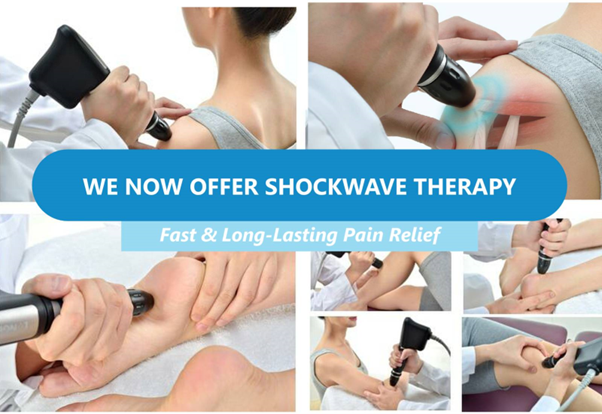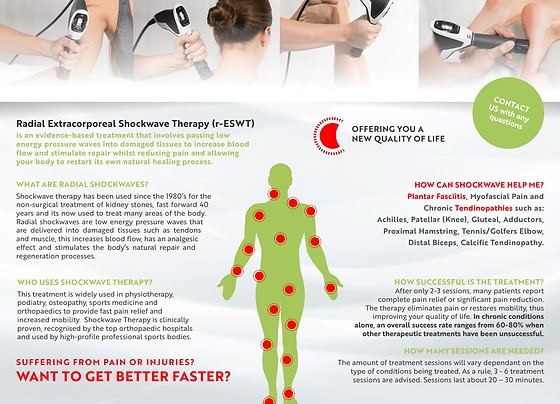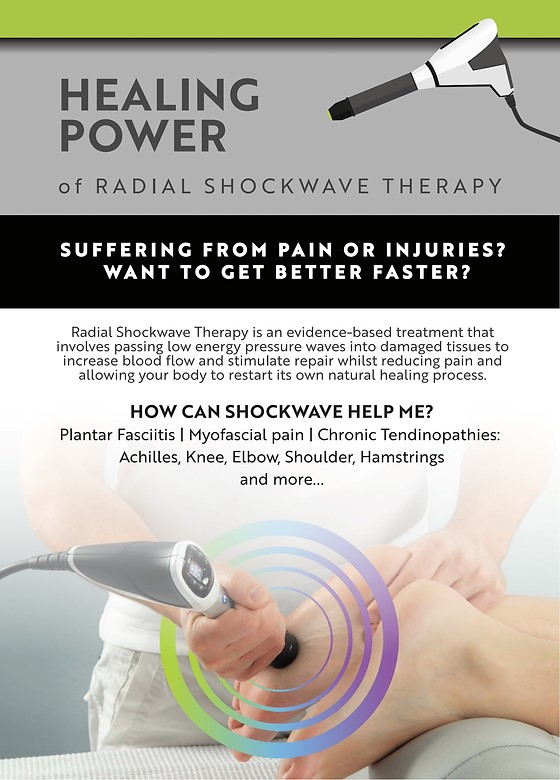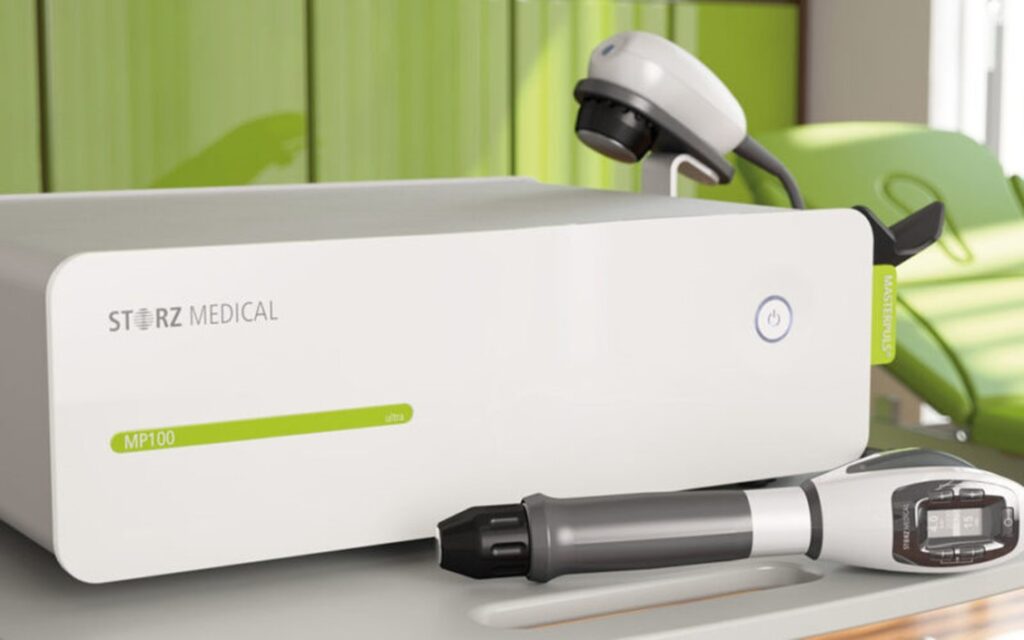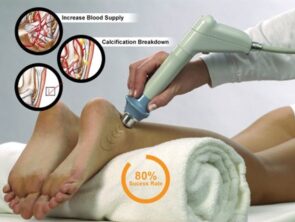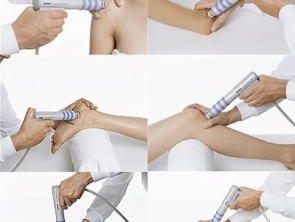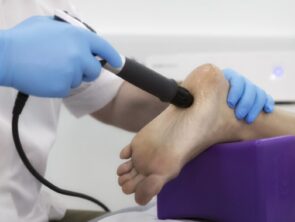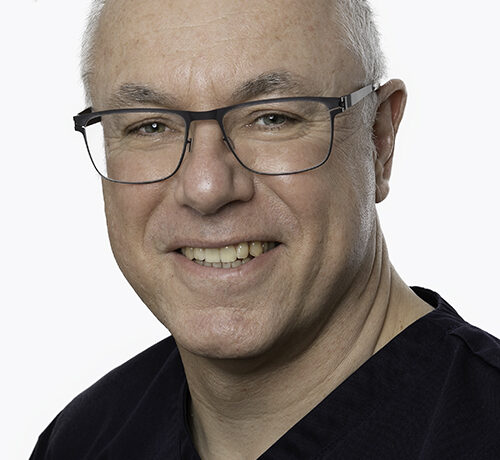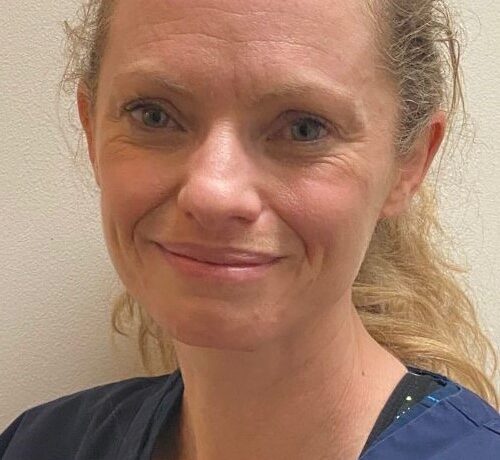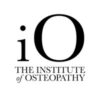What is Shockwave Therapy and does it really work? Watch the video below to find out more:

What is Radial Shockwave Therapy?
Radial Shockwave Therapy or Extracorporeal Shockwave Therapy (ESWT) is an evidence-based, cutting-edge technology treatment that involves passing low energy pressure waves into damaged tissues to increase blood flow and stimulate repair whilst reducing pain and allowing your body to restart it’s own natural healing process, which is particularly helpful for chronic tendon injuries.
What conditions can be treated with shockwave therapy?
Achilles Tendinopathy
Shockwave Therapy has proven effective in treating insertional and mid-portion Achilles Tendinopathies, an overuse injury of the Achilles tendon, the band of tissue that connects calf muscles at the back of the lower leg to your heel bone. This injury is common among runners and tennis players.
Tennis and Golfers Elbow
ESWT is proven effective in treating Tennis Elbow or lateral elbow pain. Injuries here can occur through gripping and overuse of the soft tissue that stabilises the elbow when at work, in everyday life and in sports such as tennis, squash and CrossFit.
Plantar Fasciopathy (Plantar fasciitis)
Shockwave Therapy is suitable for treating Plantar Fasciitis, an injury often caused by overuse of the soft tissue that connects the heel to the toes. The condition is often worse when you start walking after a period of rest. It is more common if you do sports activities such as running, football, and rugby, and walking in shoes with poor support.
Gluteal tendinopathy or Greater Trochanteric Pain Syndrome
ESWT is suitable to treat lateral hip pain (also known as Gluteus medius tendinopathy or Greater Trochanteric Pain Syndrome- GTPS). This is where the muscle attaches to the prominent part of your Femur found on the side of your hip. Whilst it isn’t evident why we get an injury in that part, ESWT is a game-changer to recover full function.
Common conditions also helped by shock wave include:
Runners Knee (patella tendinopathy), Shoulder Tendinopathy, Chronic Proximal Hamstring tendinopathy, Chronic Distal Biceps Tendinopathy, Calcific Tendinopathy, Muscle Pain, Osgood Schlatters, Peroneal Tendinopathy, Shin Splints, Myofascial pain and Chronic Adductor tendinopathy.
What are the benefits of Shock Wave Therapy?
Avoid Surgery
Shockwave Therapy or Extracorporeal Shockwave Therapy (ESWT) is an entirely non-invasive alternative to surgery.
Proven Results
Shockwave Therapy has a 60-90% effectiveness in treating tendinopathy-related injuries. Research trials have clinically proven it to provide up to 90%* reduction in pain and functional improvement conditions such as Tennis Elbow and Plantar Fasciitis.
 The benefit over other interventions, e.g. chronic tendinopathy and plantar fasciitis, is that long term outcomes (1 year +) are excellent, whereas most other interventions only work for a short period. Combining appropriate rehabilitation magnifies the effects and further reduces the chances of relapse. Shockwave Therapy is clinically proven, recognised by top orthopaedic hospitals and used by high-profile professional sports bodies.
The benefit over other interventions, e.g. chronic tendinopathy and plantar fasciitis, is that long term outcomes (1 year +) are excellent, whereas most other interventions only work for a short period. Combining appropriate rehabilitation magnifies the effects and further reduces the chances of relapse. Shockwave Therapy is clinically proven, recognised by top orthopaedic hospitals and used by high-profile professional sports bodies.
Minimal Downtime
Compared to surgery, patients can also expect minimal downtime and side effects from Shockwave Therapy.
Shockwave Therapy can be used in chronic conditions where other options have failed, instead of surgery or where surgery isn’t an option (e.g. due to certain health conditions or medications).
Frequently Asked Questions
Absolutely! Shockwave therapy is clinically proven and well approved of by the top orthopaedic hospitals, and used by well-established professional sports bodies including:
- National Institute of Clinical Excellence (NICE)
- English Institute of Sport
- UK Athletics
- Welsh Rugby Union
- Premier League Football Clubs
Research literature suggests that the recommended course of treatments which patients receive, is a minimum of 3, weekly spaced shockwave treatments, and the results can be amazing!
There is a large body of evidence, which is continually growing, that supports shockwave therapy as a safe, non-invasive treatment modality, with studies reporting success rates upwards of 70% for tendinopathies. Shockwave therapy has been found to significantly reduce the pain that accompanies tendon injuries and improves functionality and quality of life.
The National Institute for Health and Care Excellence (NICE) considers extracorporeal shockwave therapy to be a safe procedure. NICE has produced guidelines on using the therapy which we follow carefully.
“(ESWT) offers two main advantages over traditional surgical methods: fewer potential complications and faster return to normal activity.” (FDA2007)
Shockwave Therapy involves passing short, intense sound waves into affected tissues, increasing blood flow with an analgesic effect, and stimulates metabolic repair and regeneration in the tissue.
Quick and effective, the treatment puts the cells into repair mode and allows your body to restart its accelerated healing process.
Shockwave therapy is an excellent treatment option especially for chronic conditions which aren’t resolving with standard treatment. In a nutshell, it:
- Increases tendon blood supply
- Breaks up calcification
- Stimulates regeneration
- Releases trigger points
- Assists collagen remodelling
After your assessment and explanation, the typical shock wave session last for a few minutes.
We put some gel on the painful area and then place a hand-held device on the gel.
Shockwave therapy is delivered directly onto the skin that covers the affected area. This kind of pain relief therapy uses low energy sound, or acoustic, waves, rather than electrical waves.
These sound waves are ‘radial’ in shape and behaviour. They can easily penetrate the skin, and once through, they radiate as a shockwave throughout the affected muscle, joint or tendon. Shockwave therapy is therefore a targeted type of therapy, only treating the areas that are injured or damaged.
When you go for shockwave treatment, your therapist will use a hand-held device connected to a machine that turns compressed air into sound waves. They’ll apply some light pressure and move the device over the area that requires treatment. Ultrasound gel is applied to the skin beforehand to help transmit the shockwaves through the skin.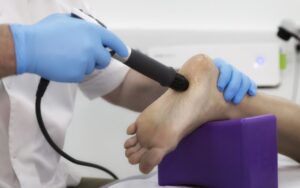
The sound waves stimulate blood flow to the area, and also causes a small amount of localised inflammation. In the days after treatment, the body will work to naturally heal this inflammation, and in doing so, stimulates the repair and regeneration of cells. Damaged or injured tissues then begin to repair and cause the associated pain to reduce.
If you have scar tissue in the area, that’s contributing to your pain, shockwave therapy will also help to break down this thick, fibrous tissue. Scar tissue causes immobility in the surrounding tissues as unlike normal tissues, it isn’t very elastic. Breaking it down using sound waves helps to improve mobility and discomfort.
During the treatment, you will hear repetitive clicking sounds.
Some patients may feel mild to moderate discomfort or a sensation similar to deep tissue massage which can be tailored by your therapist who will work with you to ensure your comfort during the therapy session.
You are then advised on a loading pattern of exercise to perform at home before your next session to improve results.
After your treatment session, you can get up and walk straight away. When you go home, you can continue your usual activities, return to work and wear your normal shoes. We recommend that you avoid strenuous exercise or running for 48 hours after the treatment.
Shockwave therapy can cause some discomfort during the treatment, as it involves the application of pressure waves to the affected area. However, the level of pain experienced can vary depending on individual sensitivity and the specific condition being treated. We aim to reproduce symptoms but only to a level of 5/10. Some people say extracorporeal shockwave therapy feels like gentle flicks against the skin. You may have a little discomfort during the short procedure but should be able to cope with this and it is a good indicator that the treatment is working. Your comfort is our priority. We can adjust the machine settings to help you manage any discomfort.
Shockwave therapy is a completely safe and effective treatment for painful tendon tissues and other conditions when performed by trained professionals. Potential side effects are rare and temporary, such as skin redness or discomfort.
The therapy has NICE guidance and is widely used within the NHS. At Back on track Healthcare, our qualified, professional therapists are trained in using shockwave therapy, ensuring the treatment is predominantly risk-free, as well as being free from any side effects.
For effective results, we recommend patients have a course of 3-5 sessions. The total amount will depend on the injury. We would start with 3, then review progress and discuss whether more sessions are needed.
Our therapists use the most up to date techniques when treating their patients, so our treatment plans are always adapting with new devices and techniques. Healthcare professionals use shockwave therapy in sports medicine, urology, orthopaedics, and veterinary medicine. It is an ideal treatment for a quick recovery as there is no need for invasive surgery or painful injections.
If you have had your condition for more than three to six months and have tried other conservative therapies with no results, do not wait. Continuously using degenerative tendon tissue can cause further damage.
If the condition progresses to a rupture, ESWT is no longer an option, and you will have no treatment alternative but invasive surgery.
Shockwave Therapy has been shown to provide pain relief and promote recovery from long-term injury in 3-5 sessions.
At Back on Track Healthcare we use the best available technology – Swiss engineered Storz devices, used by the majority of experts, major NHS hospitals and elite sporting clubs across the world. Many devices are now coming to market that have not been supported by research, externally validated, or been CE marked for safety and effectiveness. Beware of inferior quality cheaper devices.
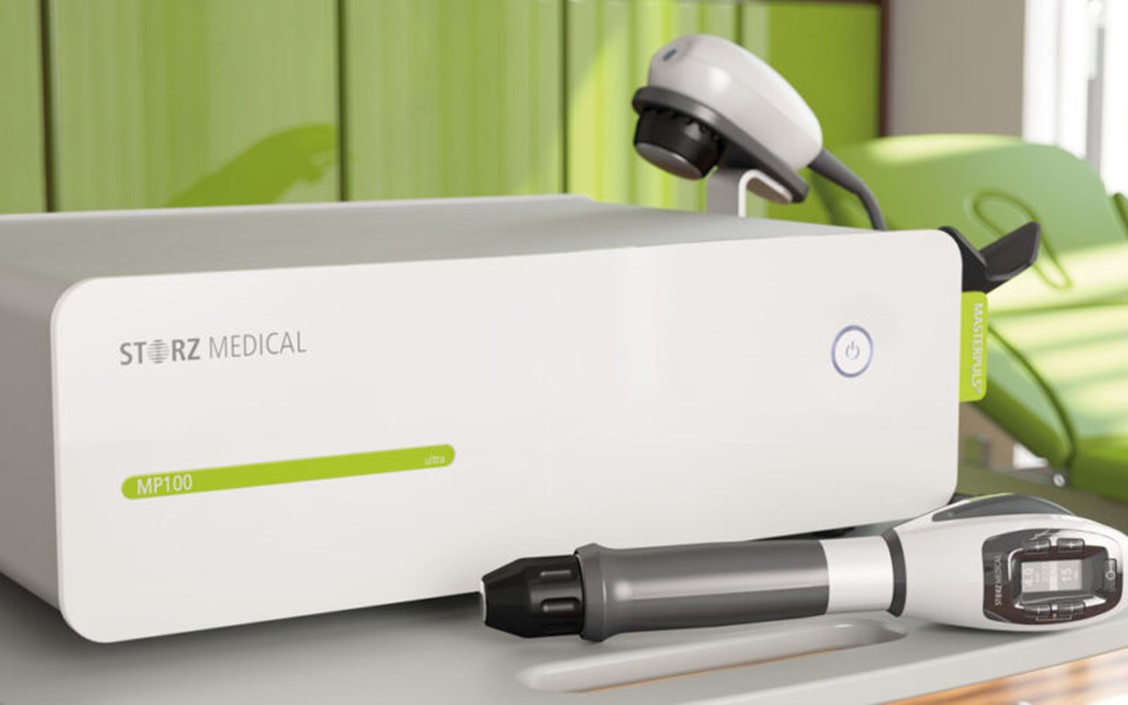
Yes, it can treat both long-term chronic conditions and newer injuries. There is substantial evidence to show that Shockwave Therapy can achieve great results even in conditions that have been present for many years.
Shockwave therapy may not suitable for clients who:
- Have a malignant tumour (cancer)
- Are pregnant or trying to conceive
- Have an infection
- Have a cardiac pacemaker other implanted devices
- Take anti-coagulants (blood thinners) such as warfarin
- Have a nerve or circulation disorder
- Seek treatment over major blood vessels and nerves
- Have open wounds
- Have had local joint replacements
- Over ununified growth epiphysial growth plates
- Have blood clotting disorders including thrombosis
- Have compromised mental status and/or the inability to cooperate.
As Radial Shockwave Therapy (RSWT) is recommended by NICE, most private medical insurers will cover this treatment. However, it is essential that patients consult their insurance companies prior to their first appointment to ensure cover is provided. We offer very competitive rates for any patient who is paying privately for Shockwave therapy.
Radial shockwaves are high-energy acoustic waves that spread out from the point of origin and disperse over a larger area. These shockwaves are generated by an electromagnetic or pneumatic device, and they spread through the skin and underlying tissues to reach the targeted area. Radial shockwaves are often used to treat musculoskeletal conditions such as plantar fasciitis, tennis elbow, and shoulder pain.
- Some of the ways that RSWT is thought to work include:
Stimulating blood flow: The high-energy acoustic waves delivered during RSWT can stimulate blood flow to the affected area. This increased blood flow can help to reduce inflammation and promote tissue regeneration. - Disrupting pain pathways: RSWT can help to disrupt pain pathways in the body by activating nerve fibres that inhibit pain signals. This can help to reduce pain and improve function.
- Promoting tissue regeneration: RSWT can stimulate the production of growth factors and other substances that promote tissue regeneration. This can help to repair damaged tissues and accelerate the healing process.
Radial shockwave therapy penetrates to a depth of 3cm to 5cm and is an effective treatment for chronic soft tissue and tendon injuries, particularly for larger treatment areas, such as muscle groups, Plantar Fasciitis, Myofascial Pain Syndrome, tendinopathies and other muscle disorders.
Shockwaves are sound waves that have specific physical characteristics, including nonlinearity, high peak pressure followed by low tensile amplitude, short rise time, and short duration (10 ms). They have a single pulse, a wide frequency range (0-20 MHz), and a high pressure amplitude (0-120 MPa)
These characteristics produce a positive and negative phase of shockwave. The positive phase produces direct mechanical forces, whereas the negative phase generates cavitation and gas bubbles that subsequently implode at high speeds, generating a second wave of shockwaves.
In comparison to ultrasound waves, the shockwave peak pressure is approximately 1000 times greater than the peak pressure of an ultrasound wave.
Shockwaves are transient pressure disturbances that propagate rapidly in three-dimensional space. They are associated with a sudden rise from ambient pressure to their maximum pressure. Significant tissue effects include cavitation, which are consequent to the negative phase of the wave propagation.
Direct shockwave and indirect cavitation effects cause hematoma formation and focal cell death, which then stimulate new bone or tissue formation.
In summary, the proposed mechanisms of action for ESWT include the following: promote pain desensitisation, neovascularization at the tendon-bone junction, stimulate proliferation of tenocytes and osteoprogenitor differentiation, increase leukocyte infiltration, and amplify growth factor and protein synthesis to stimulate collagen synthesis and tissue remodelling.
Extracorporeal Shockwave Therapy (ESWT) otherwise referred to as shockwave therapy, was first introduced into clinical practice in 1982 for the management of urologic conditions. The success of this technology for the treatment of urinary stones quickly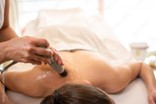 made it a first-line, noninvasive, and effective method. Subsequently, ESWT was studied in orthopedics where it was identified that it could loosen the cement in total hip arthroplasty revisions. Further, animal studies conducted in the 1980s revealed that ESWT could augment the bone-cement interface, enhance osteogenic response and improve fracture healing. While shockwave therapy has been shown to be beneficial in fracture healing, most orthopaedic research has focused on upper and lower extremity tendinopathies, fasciopathies, and soft tissue conditions.
made it a first-line, noninvasive, and effective method. Subsequently, ESWT was studied in orthopedics where it was identified that it could loosen the cement in total hip arthroplasty revisions. Further, animal studies conducted in the 1980s revealed that ESWT could augment the bone-cement interface, enhance osteogenic response and improve fracture healing. While shockwave therapy has been shown to be beneficial in fracture healing, most orthopaedic research has focused on upper and lower extremity tendinopathies, fasciopathies, and soft tissue conditions.
According to a study performed by Rompe and coworkers, stretching exercises in combination with radial shock wave therapy is more efficient for the treatment of chronic symptoms of proximal plantar fasciopathy than repetitive radial pressure wave therapy alone. Patients were subjected to three sessions of 2000 radial pressure pulses (EFD = 0.16 mJ/mm 2) in weekly intervals, generated with a ballistic device (air compressor pressure 4 bar; rate 8 Hz).
A study to investigate the clinical outcomes of ESWT on calcaneal spurs of 108 patients and its correlation with radiologic changes were reported by Yalcin et al. All the patients underwent radial pressure wave therapy once a week for 5 weeks (2000 pressure waves starting at an EFD of 0.05 mJ/mm 2 and increasing up to 0.4 mJ/mm 2). After the therapy, approximately 67 % of the patients reported no pain; however, there was no correlation between clinical outcome and radiologic changes. The authors concluded that even without radiologic change.
How much does a course of treatment cost?
As NICE (and research papers) recommend a minimum course of 3 sessions, we offer this as a standard package at a reduced rate, with top up sessions available at a stand-alone price if needed.
- Price per single session – £100
- Package price for 3 sessions – £270
- Package price for 5 sessions – £425
Additional packages covering a greater number of sessions are available at discounted rates if your clinician thinks further sessions are needed for your individual case. Please discuss this in person with your therapist.

